| Listing 1 - 10 of 18 | << page >> |
Sort by
|
Book
ISBN: 0813038936 0813036623 9780813036625 9780813038933 9780813035390 0813035392 Year: 2011 Publisher: Gainesville, FL University Press of Florida
Abstract | Keywords | Export | Availability | Bookmark
 Loading...
Loading...Choose an application
- Reference Manager
- EndNote
- RefWorks (Direct export to RefWorks)
Empire and Pilgrimage in Conrad and Joyce offers a fresh look at these two modernist writers, revealing how their rejection of organized religion and the colonial presence in their native countries allowed them to destabilize traditional notions of power, colonialism, and individual freedom in their texts.
Book
ISBN: 9401208131 9789401208130 9042035382 9789042035386 Year: 2012 Publisher: Amsterdam ; New York, NY : Rodopi,
Abstract | Keywords | Export | Availability | Bookmark
 Loading...
Loading...Choose an application
- Reference Manager
- EndNote
- RefWorks (Direct export to RefWorks)
Travelling is the art of motion, motion results in moments of human encountering, and such moments manifest themselves in unsettling linguistic repercussions and crises of meaning. Places of arrival also function as inscriptions of such meaningful repercussions, inscriptions of the past crossing the present, of the other crossing the self. The contributions in this book explore places, rituals, texts and scriptures as religious or secular inscriptions – “topographies” – of such “arrivals.” Each arrival happens , and its very place manifests itself only as a momentous component of the process itself. Arrival is an event of conclusion as well as of urgency for subsequent explorations of new meanings to be read from the topography of the place, mirroring thus a signifying dynamic for the metamorphosis of the traveller’s self: “ topodynamic ” of arrival. In this vein this book investigates for the first time the dynamic of cultural formations of space, an aspect of spatiality which since the “spatial turn” in cultural discourse has mostly been neglected.
Book
ISBN: 1476642141 Year: 2021 Publisher: Jefferson : McFarland & Company, Incorporated Publishers,
Abstract | Keywords | Export | Availability | Bookmark
 Loading...
Loading...Choose an application
- Reference Manager
- EndNote
- RefWorks (Direct export to RefWorks)
"The Camino de Santiago, the Route of Saint James, the Way-all describe a pilgrimage with multiple routes that ultimately pass through Spain and end at the Cathedral of Saint James in Santiago de Compostela. In the 21st century, this medieval tradition is seeing a revival with travelers, both spiritual and secular, who embrace it for different reasons. Offering insight into the personal journeys of contemporary pilgrims, this collection of new essays explores cultural expressions of the Camino from the perspective of literature, film and graphic novels, and looks beyond Spain and the "Caminoisation" of other historical routes"--
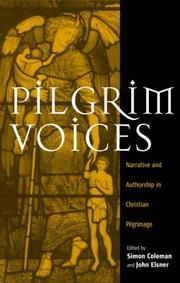
ISBN: 1571816038 1785330616 Year: 2003 Publisher: New York ; Oxford, [England] : Berghahn Books,
Abstract | Keywords | Export | Availability | Bookmark
 Loading...
Loading...Choose an application
- Reference Manager
- EndNote
- RefWorks (Direct export to RefWorks)
Research on pilgrimage has traditionally fallen across a series of academic disciplines - anthropology, archaeology, art history, geography, history and theology. To date, relatively little work has been devoted to the issue of pilgrimage as writing and specifically as a form of travel-writing. The aim of the interdisciplinary essays gathered here is to examine the relations of Christian pilgrimage to the numerous narratives, which it generates and upon which it depends. Authors reveal not only the tensions between oral and written accounts but also the frequent ambiguities of journeys - the possibilities of shifts between secular and sacred forms and accounts of travel. Above all, the papers reveal the self-generating and multiple-authored characteristics of pilgrimage narrative: stories of past pilgrimage experience generate future stories and even future journeys.
Christian pilgrims and pilgrimages in literature. --- Christian pilgrims and pilgrimages --- Travel in literature. --- Travel writing --- History. --- Christian pilgrims and pilgrimages in literature --- Travel in literature --- 248.153.8 --- 248.153.8 Bedevaarten. Pelgrimstochten--(algemeen) --- Bedevaarten. Pelgrimstochten--(algemeen) --- Voyages and travels in literature --- History
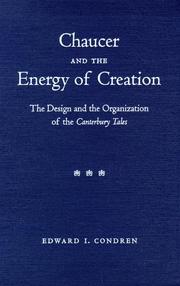
ISBN: 0813021391 9780813021393 0813016797 Year: 1999 Publisher: Gainesville University Press of Florida
Abstract | Keywords | Export | Availability | Bookmark
 Loading...
Loading...Choose an application
- Reference Manager
- EndNote
- RefWorks (Direct export to RefWorks)
Christian pilgrims and pilgrimages in literature. --- Tales, Medieval --- Storytelling in literature. --- Rhetoric, Medieval. --- Christian pilgrims and pilgrimages in literature --- Storytelling in literature --- Rhetoric, Medieval --- English --- Languages & Literatures --- English Literature --- Medieval tales --- History and criticism. --- History and criticism --- Chaucer, Geoffrey, --- Chaucer, Jeffrey, --- Chʻiao-sou, Chieh-fu-lei, --- Chieh-fu-lei Chʻiao-sou, --- Choser, Dzheffri, --- Choser, Zheoffreĭ, --- Cosvr, Jvoffrvi, --- Tishūsar, Zhiyūfrī, --- Technique.
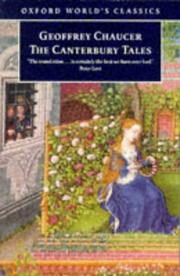
ISBN: 1283160188 9786613160188 0191585866 9780191585869 019283360X 9780192833600 019283360X 9780192833600 Year: 1998 Publisher: Oxford New York Oxford University Press
Abstract | Keywords | Export | Availability | Bookmark
 Loading...
Loading...Choose an application
- Reference Manager
- EndNote
- RefWorks (Direct export to RefWorks)
David Wright's new translation of The Canterbury Tales into modern verse--the first to appear in over thirty years--makes one of the greatest works of English literature accessible to all readers while preserving the wit and vivacity of Chaucer's original text.
Chaucer, Geoffrey, d. 1400. Canterbury tales. --- Christian pilgrims and pilgrimages in literature. --- Storytelling in literature. --- Tales, Medieval -- History and criticism. --- Christian pilgrims and pilgrimages --- English --- Languages & Literatures --- English Literature --- Pilgrims and pilgrimages, Christian --- Christian shrines --- Pilgrims and pilgrimages
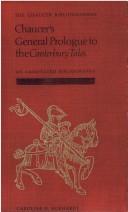
ISBN: 1282009893 9786612009891 1442672870 9781442672871 0802025927 9780802025920 0802006264 Year: 1990 Publisher: Toronto
Abstract | Keywords | Export | Availability | Bookmark
 Loading...
Loading...Choose an application
- Reference Manager
- EndNote
- RefWorks (Direct export to RefWorks)
The General Prologue to Chaucer's Canterbury Tales is one of the most enduring works of English literature. Beloved by scholars, teachers, students, and general readers, it has been given a great many different interpretations. This annotated, international bibliography of twentieth-century criticism on the Prologue is an essential reference guide. It includes books, journal articles, and dissertations, and a descriptive list of twentieth-century editions; it is the most complete inventory of modern criticism on the Prologue. The extensive annotations provide uniquely convenient access to many publications that are otherwise difficult to obtain.In her introduction, Caroline Eckhardt provides a careful and comprehensive overview of modern trends in criticism, trends which can be traced through the bibliography. At the beginning of the century, for example, Chaucer's Prologue was often described as a 'portrait gallery' and praised for its realism - social, psychological, and dramatic. Later in the century came emphases on irony, rhetoric, Freudian interpretations, elaborate allegories, and stylistic complexities. At present, the Prologue is often interpreted as a system of signs and symbols in which realism, if it exists at all, serves purposes beyond itself. The smiling and serene poet of the earlier period has been replaced by a self-conscious ironist, sometimes with a split personality. The portrait gallery of the beginning of the century is still there, though the spectator who walks along it tends to see something less fixed textually (the Prologue is now commonly discussed as work-in-progress) and more complicated structurally, generically, and thematically. It is the spectator, of course, who has changed.
Christian pilgrims and pilgrimages in literature --- English poetry --- Civilization, Medieval, in literature --- Prologues and epilogues --- Epilogues --- Postscripts (Epilogues) --- Prefaces --- Chaucer, Geoffrey, --- Canterbury tales (Chaucer, Geoffrey) --- Caxton's Chaucer (Chaucer, Geoffrey)
Book
ISBN: 0691609942 1400858313 9781400858316 0691066930 9780691066936 9780691609942 Year: 2014 Publisher: Princeton, NJ
Abstract | Keywords | Export | Availability | Bookmark
 Loading...
Loading...Choose an application
- Reference Manager
- EndNote
- RefWorks (Direct export to RefWorks)
Paul Olson argues that Chaucer's narratives emerge from his deep concern about the crises of late fourteenth-century England and his vision of the renewal of that troubled society through the ideal of parlement, the various orders of society speaking together, and through a perfective religious discipline.Originally published in 1987.The Princeton Legacy Library uses the latest print-on-demand technology to again make available previously out-of-print books from the distinguished backlist of Princeton University Press. These editions preserve the original texts of these important books while presenting them in durable paperback and hardcover editions. The goal of the Princeton Legacy Library is to vastly increase access to the rich scholarly heritage found in the thousands of books published by Princeton University Press since its founding in 1905.
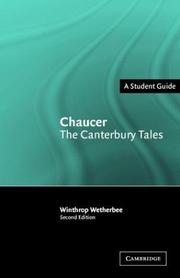
ISBN: 9780511803321 9780521832496 9780521540100 9780511164132 0511164130 0511162537 9780511162534 0521832497 0521540100 0511166087 9780511166082 051180332X 9780511164934 0511164939 0511164130 0521832497 0521540100 1107148847 9781107148840 1283329158 9781283329156 0511165420 9780511165429 9786613329158 6613329150 0511566794 9780511566790 Year: 2004 Publisher: Cambridge New York Cambridge University Press
Abstract | Keywords | Export | Availability | Bookmark
 Loading...
Loading...Choose an application
- Reference Manager
- EndNote
- RefWorks (Direct export to RefWorks)
This introductory guide places the Canterbury Tales in the context of the crisis in English society in the fourteenth century. It examines the social diversity of Chaucer's pilgrims, the stylistic range of their tales and the psychological richness of their interaction. The volume offers students a clear image of the powerful representation of the social reality that makes the Canterbury Tales one of the most important texts in English literature. Emphasis is placed on the language of the poem, the place of Chaucer in subsequent literary tradition, and an entire chapter is devoted to the General Prologue which is widely studied on undergraduate courses. Finally, the volume offers a helpful chronology of the period and an invaluable guide to further reading.
820 "13" CHAUCER, GEOFFREY --- 820 "13" CHAUCER, GEOFFREY Engelse literatuur--?"13"--CHAUCER, GEOFFREY --- Engelse literatuur--?"13"--CHAUCER, GEOFFREY --- Christian pilgrims and pilgrimages in literature. --- Tales, Medieval --- History and criticism. --- Chaucer, Geoffrey, --- Arts and Humanities --- Literature
Book
ISBN: 1282601474 9786612601477 9047428447 9789047428442 9781282601475 9789004174986 9004174982 6612601477 Year: 2009 Publisher: Leiden Boston Brill
Abstract | Keywords | Export | Availability | Bookmark
 Loading...
Loading...Choose an application
- Reference Manager
- EndNote
- RefWorks (Direct export to RefWorks)
The early modern era is often envisioned as one in which European genres, both narrative and visual, diverged indelibly from those of medieval times. This collection examines a disparate set of travel texts, dating from the thirteenth to the seventeenth centuries, to question that divergence and to assess the modes, themes, and ethnologies of travel writing. It demonstrates the enduring nature of the itinerary, the variant forms of witnessing (including imaginary maps), the crafting of sacred space as a cautionary tale, and the use of the travel narrative to represent the transformation of the authorial self. Focusing on European travelers to the expansive East, from the soft architecture of Timur's tent palaces in Samarqand to the ambiguities of sexual identity at the Mughul court, these essays reveal the possibilities for cultural translation as travelers of varying experience and attitude confront remote and foreign (or not so foreign) space.
Europeans --- Travelers' writings, European --- Literary form --- Ethnology in literature. --- Pilgrims and pilgrimages in literature. --- Intercultural communication in literature. --- Travel --- History and criticism. --- History. --- Themes, motives. --- Asia --- Description and travel. --- In literature.
| Listing 1 - 10 of 18 | << page >> |
Sort by
|

 Search
Search Feedback
Feedback About UniCat
About UniCat  Help
Help News
News